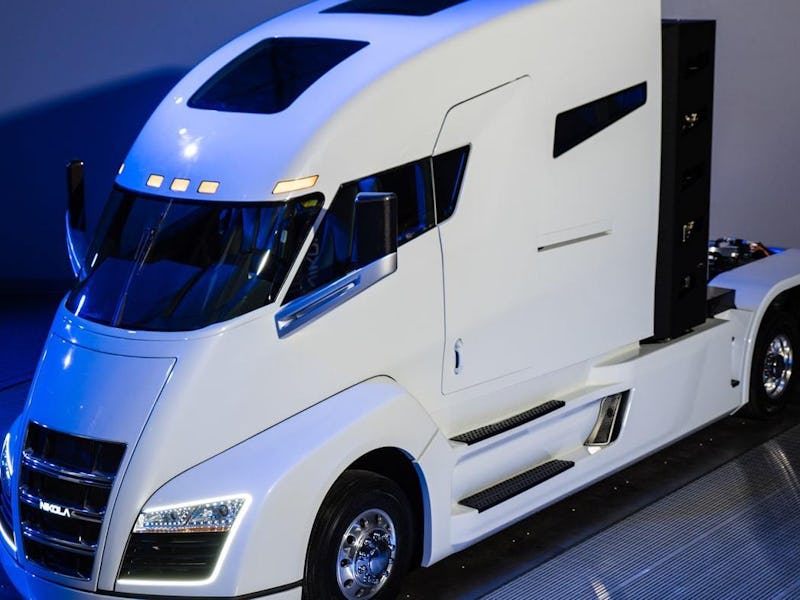Nikola CEO Says Zero-Emissions Semi-Trucks Face Crunching Demand

Since Nikola Motor Company — the start-up that wants to make hydrogen-powered semi-trucks — pulled back the curtain on its two prototypes a week ago, CEO Trevor Milton has heard from trucking companies around the world.
“We’ll be booked out at max capacity for probably 10 to 20 years,” just from the demand in the U.S. and Canada, Milton told Inverse recently. “So it’s hard to move into other countries when you’re at 100 percent capacity here.”
So, companies in other countries will have to wait to become Nikola customers, not that it doesn’t have serious competition: For one, Tesla has its own plan for zero-emissions trucking.
Milton says the demand is “really the biggest problem we have: How do we build enough trucks to satisfy the market? And it’s going to take us a long time to build the factories, get the service centers up and flowing, and so on.”
But the Salt Lake City-based company is preparing for the launch of its trucks in the United States and Canada, expected to happen sometime between 2019 and 2021.
Nikola faces challenges on a few fronts: It needs to develop a network of charging stations so the hydrogen cells that power the trucks can be powered-up between trips. Filling up a diesel tank is easy; refueling a hydrogen-powered vehicle requires dedicated stations that have yet to be built. It could take 50 years for the trucking industry to fully shift to hydrogen power.
The Nikola One, an electric sleeper semi-truck.
It’s a prediction that might have made skeptics squirm, especially if they know the Nikola One model was originally supposed to be powered by a natural gas turbine — not a hydrogen fuel cell.
Milton tells Inverse that the turbine was too loud, though, and it wasn’t as environmentally friendly as hydrogen. He says the turbine released fewer emissions than diesel engines, but the company decided it didn’t make sense to release a low-emission product when its long-term goal was zero-emission vehicles.
So the company decided to wait until its hydrogen fuel cell — which was being developed at the same time as the turbine — was ready instead of rushing its trucks to market.
After the design was revealed in May, the revised Nikola One was unveiled on December 2 to an invitation-only crowd in Salt Lake City. The truck promises 1,000 horsepower; 2,000 pound-foot of torque; and a range of 800 to 1,200 miles. By comparison, Tesla’s Model S lineup has a range of 183 to 295 miles, depending on driving speed and the model being driven.
Nikola Two, which has the same powertrain without the sleeping cabin, was also revealed last week. Both have already become hits. Milton wouldn’t offer specifics about how much interest he’s received, but consulting firm Strategy& estimates that the global trucking industry will ship roughly 3.6 billion units by 2020. American Trucking Associations estimates 34.5 million trucks and trailers are used in the United States alone, not including those used by the government or farmers.
There’s Plenty of Work Ahead
Nikola plans to start work on a factory in 2017 and add hundreds of hydrogen refueling stations across the United States and Canada in 2018.
That construction is needed to make Nikola’s trucks viable, though. The U.S. Department of Energy’s Alternative Fuels Data Center report shows there are currently 31 hydrogen stations in the United States.
And to power those stations, Nikola plans to install the solar panels.
Investors want to know a company like Nikola isn’t operating at its peak right away, Milton says. Instead they look for the longevity. There’s a good chance that they also like money, which Nikola will have if everything goes to plan: Nikola One pre-orders alone reached $2.3 billion in June and have since risen to around $3 billion, the company recently announced.
Nikola will bring its tech to more than just long-haul trucking, too. Milton says he expects the company to unveil new markets — “anything in the heavy vehicle market” — once Nikola One and Nikola Two are rolling. (He says the municipal sanitation industry is one example of where it might head next.) The company could also work on hydrogen-powered buses, which are already used in California’s Coachella Valley, will soon debut in London, and Toyota plans to launch similar vehicles for the 2020 Olympics.
Work on those new models will happen over the next 10 to 15 years, but it will take even longer for hydrogen-powered trucks to replace their diesel predecessors.
“It took 50 years for diesel to really saturate the market,” Milton tells Inverse. “It’s going to take just as long to replace them with zero-emission vehicles as well. It’ll be a long, long process, but it’ll be fun.”